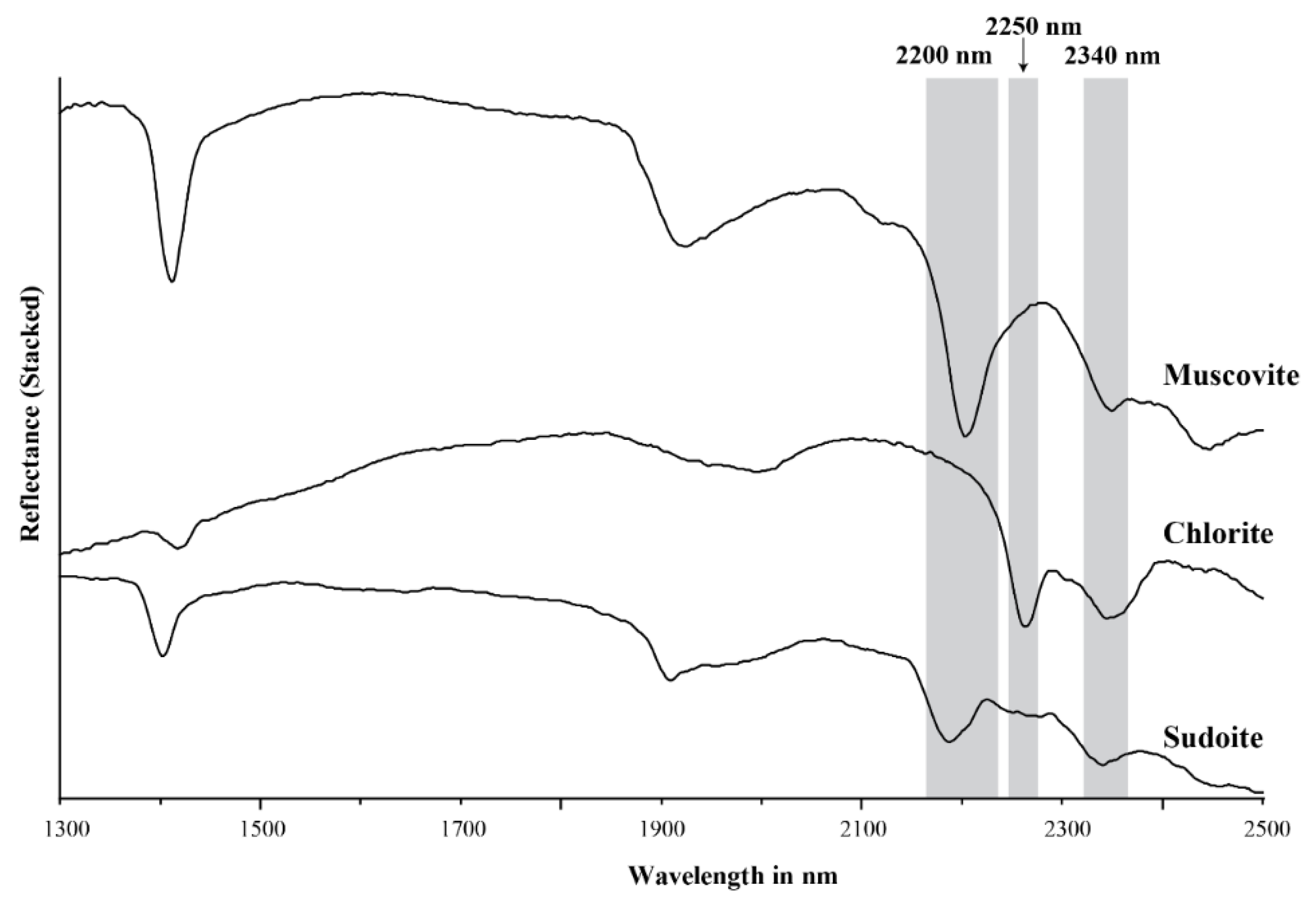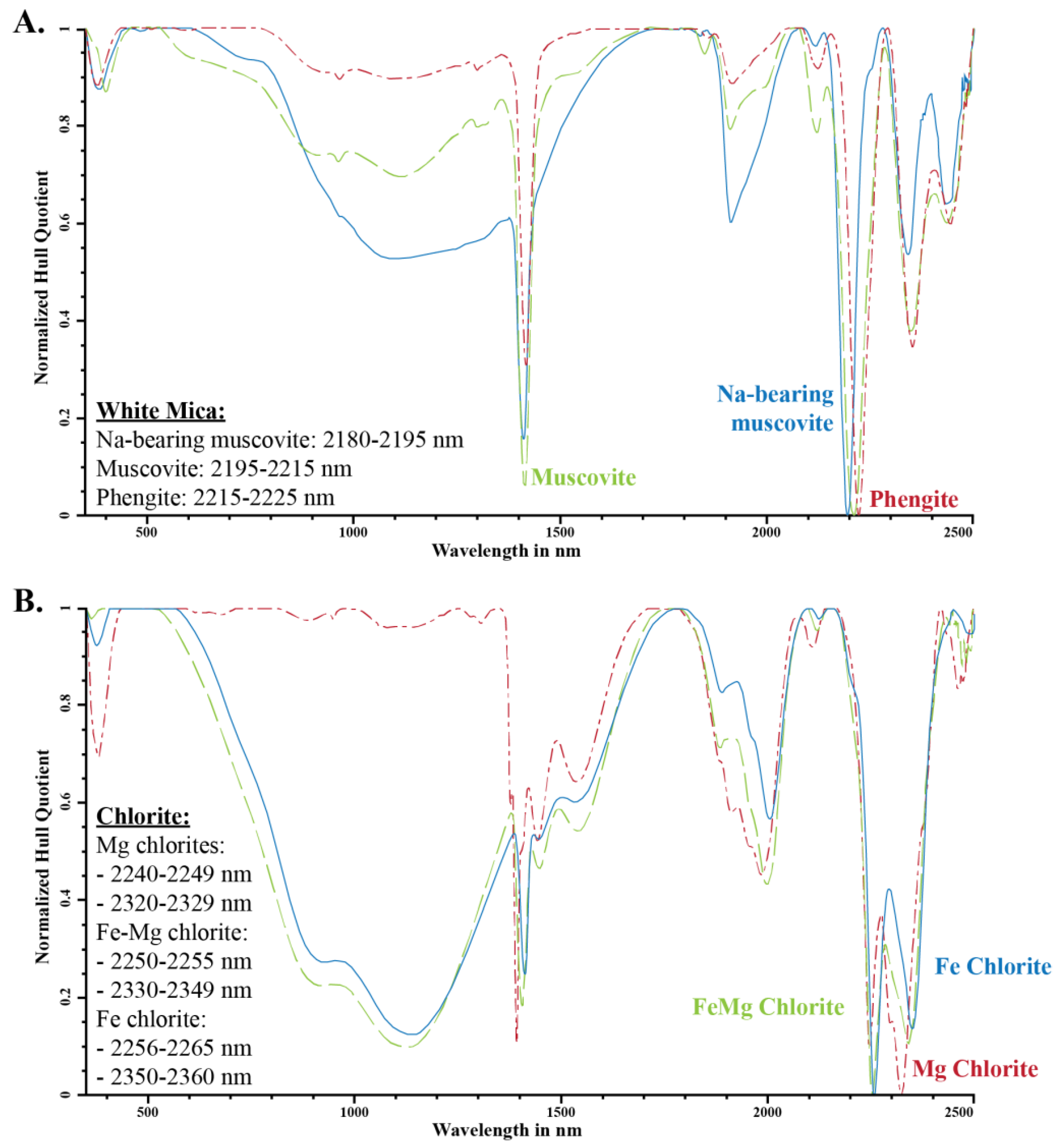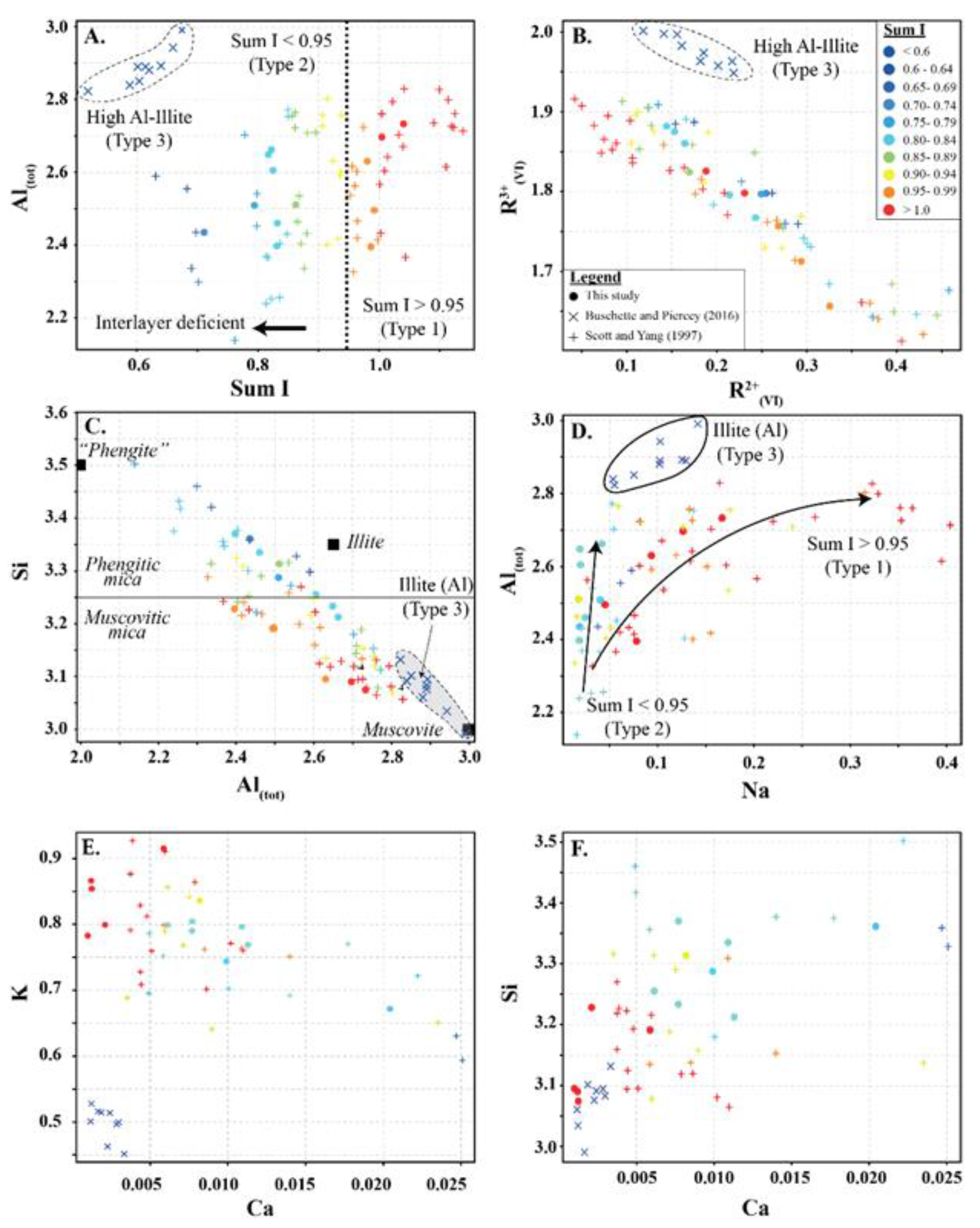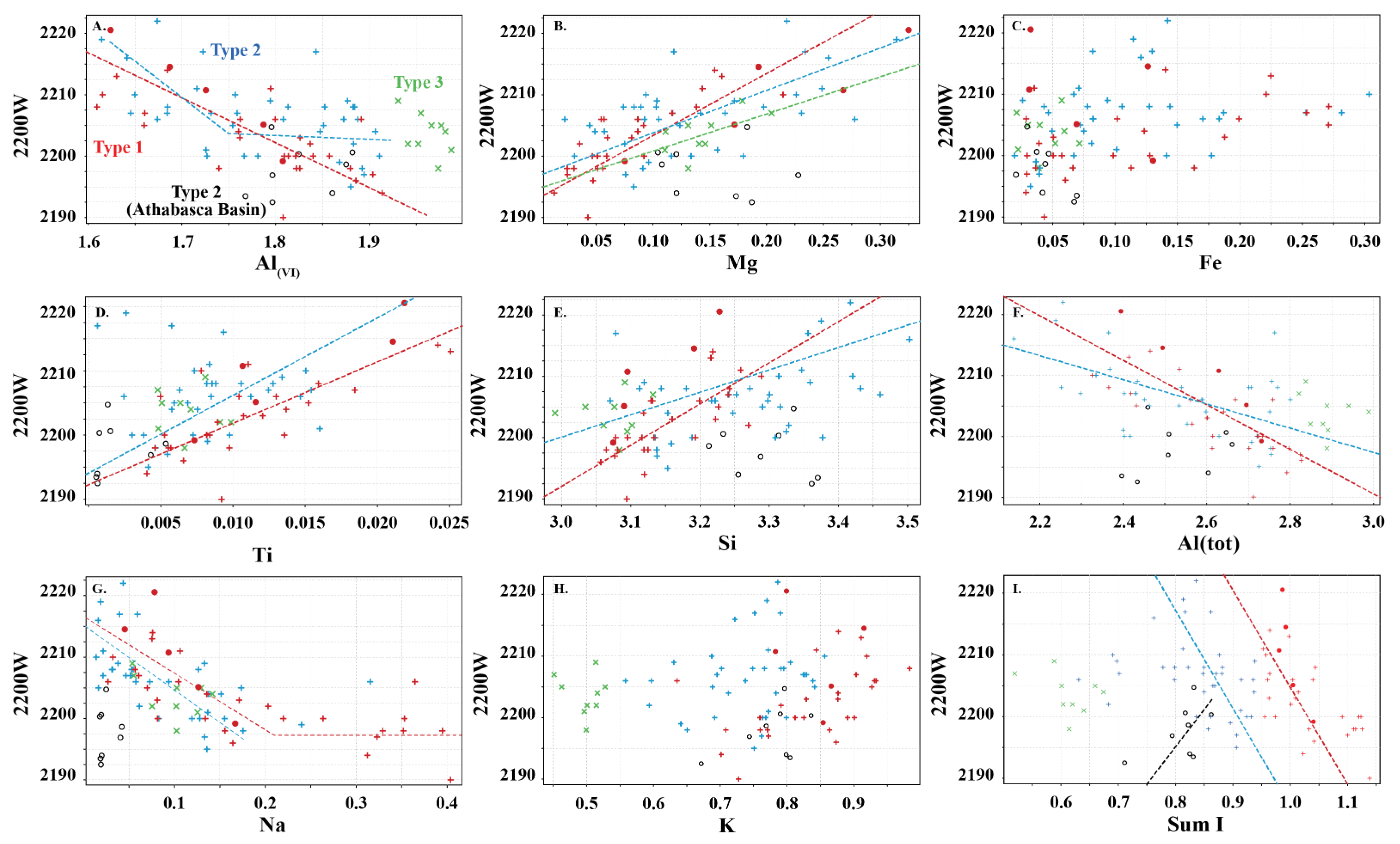Mineralogy, Mineral Chemistry and SWIR Spectral Reflectance of Chlorite and White Mica
Abstract
:1. Introduction
2. Mineralogy Background
2.1. White Mica Group
2.2. Chlorite Group
3. Spectral Reflectance Background
3.1. OH Stretching Vibrations
3.2. White Mica Group
3.3. Chlorite Group
4. Methodology
5. Results
5.1. White Mica Chemistry
5.2. White Mica SWIR Reflectance
5.3. Chlorite Chemistry
5.4. Chlorite SWIR Reflectance
6. Discussion
6.1. Spectral Signatures of White Mica
6.2. Spectral Signature of Chlorite
7. Conclusions
Author Contributions
Funding
Acknowledgments
Conflicts of Interest
References
- Ridley, J. Ore Deposit Geology; Cambridge University Press: Cambridge, UK, 2013; 398p. [Google Scholar]
- Robb, L. Introduction to Ore-Forming Processes; Blackwell Science, Ltd.: Oxford, UK, 2013; 373p. [Google Scholar]
- Cloutier, J.; Piercey, S.J. Tracing Mineralogy and Alteration Intensity Using the Spectral Alteration Index and Depth Ratios at the Northwest Zone of the Lemarchant Volcanogenic Massive Sulfide Deposit, Newfoundland, Canada. Econ. Geol. 2020, 115, 1055–1078. [Google Scholar] [CrossRef]
- Clark, R.N.; King, T.V.V.; Klejwa, M.; Swayze, G.A.; Vergo, N. High spectral resolution reflectance spectroscopy of minerals. J. Geophys. Res. 1990, 95, 12653–12680. [Google Scholar] [CrossRef] [Green Version]
- Post, J.L.; Noble, P.L. The near-infrared combination band frequencies of dioctahedral smectites, micas and illites. Clays Clay Miner. 1993, 41, 639–644. [Google Scholar] [CrossRef]
- Pontual, S.; Merry, N.; Gamson, P. G-Mex Volume l: Spectral Interpretation Field Manual; Ausspec International, Pty. Ltd.: Arrowtown, New Zealand, 1997. [Google Scholar]
- Scott, K.M.; Yang, K. Spectral Reflectance Studies of White Micas; CSIRO/AMIRA Project P435, Report 439R; Australian Mineral Industries Research Association, Ltd.: Parkville, Australia, 1997; 35p. [Google Scholar]
- Scott, K.M.; Yang, K.; Huntington, J.F. The Application of Spectral Reflectance Studies of Chlorites in Exploration; CSIRO/AMIRA Project P435A, CSIRO Exploration and Mining Report P545R; North Ryde NSW: Sydney, Australia, 1998; 88p. [Google Scholar]
- Herrmann, W.; Blake, M.; Doyle, M. Short Wavelength Infrared (SWIR) Spectral Analysis of Hydrothermal Alteration Zones Associated with Base Metal Sulfide Deposits at Rosebery and Western Tharsis, Tasmania, and Highway-Reward, Queensland. Econ. Geol. 2001, 96, 939–955. [Google Scholar] [CrossRef]
- Buschette, M.J.; Piercey, S.J. Hydrothermal alteration and lithogeochemistry of the Boundary volcanogenic massive sulphide deposit, central Newfoundland, Canada. Can. J. Earth Sci. 2016, 53, 506–527. [Google Scholar] [CrossRef] [Green Version]
- Ross, P.-S.; Bourke, A.; Schnitzler, N.; Conly, A. Exploration Vectors from Near Infrared Spectrometry near the McLeod Volcanogenic Massive Sulfide Deposit, Matagami District, Québec. Econ. Geol. 2019, 114, 613–638. [Google Scholar] [CrossRef]
- Rieder, M.; Cavazzini, G.; D’Yakonov, Y.S.; Frank-Kamenetskii, V.A.; Gottardi, G.; Guggenheim, S.; Koval, P.V.; Müller, G.; Neiva, A.M.R.; Radoslovich, E.W.; et al. Nomenclature of the micas. Miner. Mag. 1999, 63, 267–279. [Google Scholar] [CrossRef]
- Tischendorf, G.; Förster, H.-J.; Gottesmann, B.; Rieder, M. True and brittle micas: Composition and solid-solution series. Miner. Mag. 2007, 71, 285–320. [Google Scholar] [CrossRef]
- Deer, W.A.; Howie, R.A.; Zussman, J. An Introduction to the Rock-Forming Minerals; Longman Group Limited: London, UK, 1992; 696p. [Google Scholar]
- Zane, A.; Weiss, Z. A procedure for classifying rock-forming chlorites based on microprobe data. Rend. Lincei Sci. Fis. Nat. 1998, 9, 51–56. [Google Scholar] [CrossRef]
- Meunier, A. Argiles; Contemporary Publishing International—GB Science Publisher: Paris, France, 2003; 433p. [Google Scholar]
- Wiewióra, A.; Weiss, Z. Crystallochemical classifications of phyllosilicates based on the unified system of projection of chemical composition: II. The chlorite group. Clay Miner. 1990, 25, 83–92. [Google Scholar] [CrossRef]
- Farmer, V.C. The Infrared Spectra of Minerals; Mineralogical Society: London, UK, 1974; 539p. [Google Scholar]
- Hunt, G.R. Spectral signatures of particulate minerals in the visible and near infrared. Geophysics 1977, 42, 501–513. [Google Scholar] [CrossRef] [Green Version]
- Clark, R.N. Spectroscopy of Rocks and Minerals, and Principles of Spectroscopy. In Remote Sensing for the Earth Sciences: Manual of Remote Sensing, 3rd ed.; Rencz, A.M., Ed.; Wiley: New York, NY, USA, 1999; Chapter 1; Volume 3, 728p. [Google Scholar]
- Swayze, G.A.; Clark, R.N.; Goetz, A.F.; Livo, K.E.; Breit, G.N.; Kruse, F.A.; Sutley, S.J.; Snee, L.W.; Lowers, H.A.; Post, J.L.; et al. Mapping Advanced Argillic Alteration at Cuprite, Nevada, Using Imaging Spectroscopy. Econ. Geol. 2014, 109, 1179–1221. [Google Scholar] [CrossRef]
- Vedder, W.; McDonald, R.S. Vibrations of the OH Ions in Muscovite. J. Chem. Phys. 1963, 38, 1583–1590. [Google Scholar] [CrossRef]
- Slonimskaya, M.V.; Besson, G.; Dainyak, L.G.; Tchoubar, C.; Drits, V.A. Interpretation of the IR spectra of celadonites and glauconites in the region of OH-stretching frequencies. Clay Miner. 1986, 21, 377–388. [Google Scholar] [CrossRef]
- Robert, J.-L.; Kodama, H. Generalization of the correlations between hydroxyl-stretching wavenumbers and composition of micas in the system K2O–MgO–Al2O3–SiO2–H2O: A single model for trioctahedral and dioctahedral mica. Am. J. Sci. 1988, 288, 196–212. [Google Scholar]
- Besson, G.; Drits, V.A. Refined relationships between chemical composition of dioctahedral fine-dispersed mica minerals and their infrared spectra in the OH stretching region. Part I. Identification of the stretching bands. Clays Clay Miner. 1997, 45, 158–169. [Google Scholar] [CrossRef]
- Besson, G.; Drits, V.A. Refined relationship between chemical composition of dioctahedral fine-dispersed mica minerals and their infrared spectra in the OH stretching region. Part II. The main factors affecting OH vibration and quantitative analysis. Clays Clay Miner. 1997, 45, 170–183. [Google Scholar] [CrossRef]
- Martínez-Alonso, S.; Rustad, J.R.; Goetz, A.F. Ab initio quantum mechanical modeling of infrared vibrational frequencies of the OH group in dioctahedral phyllosilicates. Part II: Main physical factors governing the OH vibrations. Am. Miner. 2002, 87, 1224–1234. [Google Scholar] [CrossRef]
- Bookin, A.S.; Drits, V.A. Factors affecting orientation of OH vector in mica. Clays Clay Miner. 1982, 30, 415–421. [Google Scholar] [CrossRef]
- Redhammer, G.J.; Beran, A.; Schneider, J.; Amthauer, G.; Lottermoser, W. Spectroscopic and structural properties of synthetic micas on the annite- siderophyllite binary: Synthesis, crystal structure refinement, Mössbauer, and infrared spectroscopy. Am. Mineral. 2000, 85, 449–465. [Google Scholar] [CrossRef]
- Duke, E.F. Near infrared spectra of muscovite, Tschermak substitution, and metamorphic reaction progress: Implications for remote sensing. Geology 1994, 22, 621–624. [Google Scholar] [CrossRef]
- Duke, E.F.; Lewis, R.S. Near infrared spectra of white mica in the Belt Supergroup and implications for metamorphism. Am. Miner. 2010, 95, 908–920. [Google Scholar] [CrossRef]
- van Ruitenbeek, F.J.A.; Cudahy, T.; Hale, M.; van der Meer, F.D. Tracing fluid pathways in fossil hydrothermal systems with near-infrared spectroscopy. Geology 2005, 33, 597–600. [Google Scholar] [CrossRef]
- Kokaly, R.F.; Clark, R.N.; Swayze, G.A.; Livo, K.E.; Hoefen, T.M.; Pearson, N.C.; Wise, R.A.; Benzel, W.M.; Lowers, H.A.; Driscoll, R.L.; et al. USGS Spectral Library Version 7: U.S. Geological Survey Data Series 1035; U.S. Geological Survey: Reston, VA, USA, 2017; 61p. [CrossRef]
- McLeod, R.L.; Gabell, A.R.; Green, A.A.; Gardavsky, V. Chlorite infrared spectral data as proximity indicators of volcanogenic massive sulphide mineralization. In Proceedings of the Pacific Rim Congress ’87, Gold Coast, QLD, Australia, 26–29 August 1987; pp. 321–324. [Google Scholar]
- Zhang, G.; Wasyliuk, K.; Pan, Y. The characterization and quantitative analysis of clay minerals in the athabasca basin, saskatchewan: Application of shortwave infrared reflectance spectroscopy. Can. Miner. 2001, 39, 1347–1363. [Google Scholar] [CrossRef] [Green Version]
- Percival, J.B.; Bosman, S.A.; Potter, E.G.; Peter, J.M.; Laudadio, A.B.; Abraham, A.C.; Shiley, D.A.; Sherry, C. Customized Spectral Libraries for Effective Mineral Exploration: Mining National Mineral Collections. Clays Clay Miner. 2018, 66, 297–314. [Google Scholar] [CrossRef]


 (Buschette and Piercey, [10]).
(Buschette and Piercey, [10]).
 (Buschette and Piercey, [10]).
(Buschette and Piercey, [10]).
 (Buschette and Piercey, [10]).
(Buschette and Piercey, [10]).
 (Buschette and Piercey, [10]).
(Buschette and Piercey, [10]).
 (Buschette and Piercey, [10]).
(Buschette and Piercey, [10]).
 (Buschette and Piercey, [10]). Additionally, shown are trends of Type 1, Type 2 and Type 3 (excluding Athabasca Basin samples; open black circles) and their correlation coefficients. A separate trend is shown for the Athabasca Basin samples.
(Buschette and Piercey, [10]). Additionally, shown are trends of Type 1, Type 2 and Type 3 (excluding Athabasca Basin samples; open black circles) and their correlation coefficients. A separate trend is shown for the Athabasca Basin samples.
 (Buschette and Piercey, [10]). Additionally, shown are trends of Type 1, Type 2 and Type 3 (excluding Athabasca Basin samples; open black circles) and their correlation coefficients. A separate trend is shown for the Athabasca Basin samples.
(Buschette and Piercey, [10]). Additionally, shown are trends of Type 1, Type 2 and Type 3 (excluding Athabasca Basin samples; open black circles) and their correlation coefficients. A separate trend is shown for the Athabasca Basin samples.
 (Buschette and Piercey, [10]).
(Buschette and Piercey, [10]).
 (Buschette and Piercey, [10]).
(Buschette and Piercey, [10]).
 (Buschette and Piercey, [10]).
(Buschette and Piercey, [10]).

| Bond Pair | ν(OH) | δ(OH) |
|---|---|---|
| Wave Number (cm−1) | Wave Number (cm−1) | |
| Al–Al | 3658 (1) | 915 (2) |
| Al–Al | 3641 (1) | 915 (2) |
| Al–Al | 3621 (1) | 915 (2) |
| Al–Mg | 3604 (1) | 840 (2) |
| Al–Fe3+ | 3573 (1) | 875 (3) |
| Al–Fe2+ | 3559 (1) | N/A |
| Al–Fe2+ | 3600 (4) | N/A |
| Mg–Mg | 3583 (1) | 600–670 (2) |
| Mg–Fe3+ | 3558 (1) | 800 (2) |
| Mg–Fe2+ | 3559 (1) | N/A |
| Fe3+–Fe3+ | 3535 (1) | 818 (2) |
| Fe2+–Fe3+ | 3521 (1) | 800 (2) |
| Fe2+–Fe2+ | 3505 (1) | N/A |
| ν(OH) | δ(OH) | Overtone | |||
|---|---|---|---|---|---|
| Bond Pair | Wave Number (cm−1) | Bond Pair | Wave Number (cm−1) | Wave Number (cm−1) | nm |
| Al–Al | 3658 (1) | Al–Al | 915 (2) | 4573 | 2187 |
| Al–Al | 3641 (1) | Al–Al | 915 (2) | 4556 | 2195 |
| Al–Al | 3621 (1) | Al–Al | 915 (2) | 4536 | 2205 |
| Al–Mg | 3604 (1) | Al–Al | 915 (2) | 4519 | 2213 |
| Al–Fe3+ | 3573 (1) | Al–Al | 915 (2) | 4488 | 2228 |
| Al–Fe2+ | 3559 (1) | Al–Al | 915 (2) | 4474 | 2235 |
Publisher’s Note: MDPI stays neutral with regard to jurisdictional claims in published maps and institutional affiliations. |
© 2021 by the authors. Licensee MDPI, Basel, Switzerland. This article is an open access article distributed under the terms and conditions of the Creative Commons Attribution (CC BY) license (https://creativecommons.org/licenses/by/4.0/).
Share and Cite
Cloutier, J.; Piercey, S.J.; Huntington, J. Mineralogy, Mineral Chemistry and SWIR Spectral Reflectance of Chlorite and White Mica. Minerals 2021, 11, 471. https://doi.org/10.3390/min11050471
Cloutier J, Piercey SJ, Huntington J. Mineralogy, Mineral Chemistry and SWIR Spectral Reflectance of Chlorite and White Mica. Minerals. 2021; 11(5):471. https://doi.org/10.3390/min11050471
Chicago/Turabian StyleCloutier, Jonathan, Stephen J. Piercey, and Jonathan Huntington. 2021. "Mineralogy, Mineral Chemistry and SWIR Spectral Reflectance of Chlorite and White Mica" Minerals 11, no. 5: 471. https://doi.org/10.3390/min11050471






